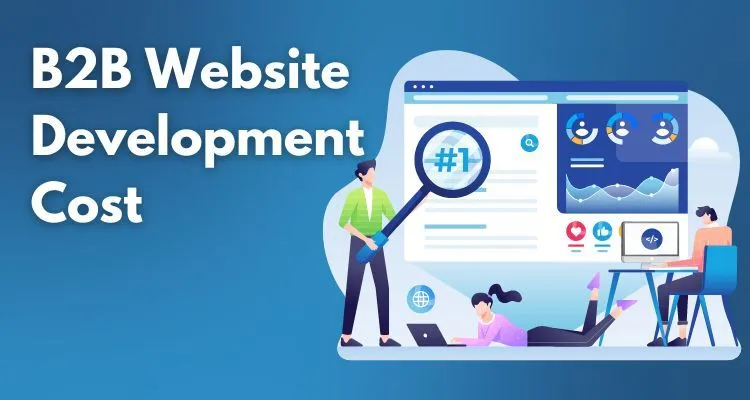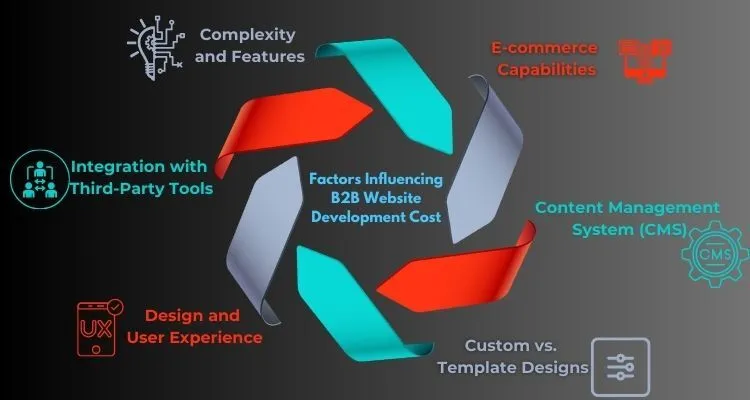- Home
- -Blog
Comprehensive Guide to B2B Website Development Costs

- 10 July 2024
- Admin
B2B Website Development Cost
When considering the development of a B2B website, understanding the associated costs is paramount. Costs can vary significantly based on the complexity of the website. For instance, basic websites may range from approximately $300 to $1000 while more intricate projects can cost anywhere from $5000 to $20000 or more.
Maintenance costs also fluctuate, with routine tasks like content updates generally being more economical compared to extensive redesigns or adding new functionalities. These figures are rough estimates and the actual expenses in India hinge on the specific project requirements and the chosen service provider.
Building a B2B website involves more than just creating a digital presence. It's about crafting a platform that connects businesses, facilitates transactions, and drives growth. A well-designed B2B website can be a powerful tool for lead generation, customer engagement, and sales.
However, understanding the costs involved in B2B website development is crucial for budgeting and planning. Costs can vary widely based on several factors, from the complexity of the website to the specific features required.
Brief Overview of B2B Website Development
B2B website development focuses on creating sites that cater to the needs of other businesses. These websites often require features like user account management, order processing systems, and dropshipping integrations for seamless operations. The goal is to provide a seamless experience for business clients who may need to make bulk purchases, manage multiple accounts, or access detailed product information.
Importance of Understanding the Costs Involved
Understanding the costs involved in B2B website development helps businesses plan their budgets effectively. Without a clear idea of the expenses, businesses risk underestimating the investment required, leading to delays and potential overspending.
Here are some key statistics to consider:
- According to a survey by Clutch, the average cost of a website can range from $5000 to $30000 depending on the complexity and features.
- A report by Statista highlights that businesses in North America spend an average of $65000 on website development.
- Research by Deloitte indicates that 38% of businesses view cost as the primary barrier to website redesign and development projects.
By understanding these costs, businesses can make informed decisions, prioritize essential features, and allocate their resources more effectively. This ensures that the final product meets their needs without exceeding their budget.
Factors Influencing B2B Website Development Cost

Complexity and Features
The complexity of a website and the features it offers significantly impact the cost of development. A simple website with basic features will be less expensive compared to a complex site with advanced functionalities like user management, data analytics, and custom workflows. More complex features require more development time, which increases costs.
Design and User Experience
Design and user experience (UX) are crucial for a successful B2B website. A well-designed site enhances usability, making it easier for clients to navigate and interact with the business. Custom designs tailored to a company's brand and target audience are generally more expensive than standard templates due to the extra work involved in creating unique graphics, layouts, and interactive elements.
Content Management System (CMS)
The choice of a Content Management System (CMS) can also affect development costs. Open-source CMS options like WordPress vs Drupal might have lower initial costs but could require more customization and maintenance. Proprietary CMS solutions often come with higher upfront costs but may offer better support and integrated features, reducing long-term expenses.
Custom vs. Template Designs
Using pre-designed templates can save money, but they may not provide the level of customization a business needs. Custom designs, on the other hand, allow for greater flexibility and alignment with a company's branding and specific requirements. However, they are typically more expensive due to the additional time and expertise needed to create a unique design.
Integration with Third-Party Tools
Integrating third-party tools such as CRM systems, marketing automation platforms, or payment gateways can add to the overall cost. Each integration requires additional development work to ensure seamless operation and compatibility with the website. The more integrations required, the higher the cost will be.
E-commerce Capabilities
Adding e-commerce functionalities such as product catalogs, shopping carts, and payment processing increases the complexity and cost of the website. Platforms like Shopify and Magento offer built-in features to handle these requirements, but for Magento users, robust Magento web hosting becomes essential to ensure performance, security, and scalability. Features like these, along with robust security measures, compliance with payment regulations, and integration with inventory management systems, require solutions like ecommerce site search to ensure seamless navigation and product discovery, contributing to higher development costs.
By considering these factors, businesses can better understand the potential costs involved in developing a B2B website and plan their budgets accordingly.
Breakdown of B2B Website Development Costs
Initial Costs
The initial phase of B2B website development involves planning, research, and design. This phase includes:
- Requirement Analysis: Understanding the business needs, target audience, and objectives.
- Project Planning: Creating a project plan with timelines, milestones, and resource allocation.
- Wireframing and Prototyping: Developing wireframes and prototypes to visualize the site structure and user flow.
- Design Mockups: Creating design mockups for the website's look and feel.
Initial costs can range from $1000 to $5000 depending on the complexity and depth of the planning required.
Development Costs
Development costs cover the actual building of the website. These expenses include:
- Front-End Development: Coding the user interface, including HTML, CSS, and JavaScript.
- Back-End Development: Setting up the server, database, and application logic.
- Content Management System (CMS) Setup: Configuring the CMS and customizing it to meet specific needs.
- Feature Implementation: Developing and integrating required features and functionalities.
Development costs vary widely based on the complexity of the website. On average, they can range from $5000 to $50000.
Testing and Quality Assurance
Testing and quality assurance (QA) ensure the website functions correctly and meets quality standards. This phase includes:
- Functionality Testing: Checking that all features work as intended.
- Performance Testing: Ensuring the website performs well under various conditions.
- Security Testing: Identifying and fixing security vulnerabilities.
- Usability Testing: Ensuring the site is user-friendly and accessible.
QA costs can range from $1000 to $10000 depending on the extent of testing required.
Ongoing Maintenance and Support
After the website is launched, ongoing maintenance and support are necessary to keep it running smoothly. These costs include:
- Regular Updates: Updating the CMS, plugins, and security patches.
- Bug Fixes: Addressing any issues that arise post-launch.
- Content Updates: Adding and updating website content as needed.
- Technical Support: Providing support for any technical issues users might face.
Ongoing maintenance and support costs can range from $500 to $2000 per month depending on the level of support and frequency of updates required.
Cost Examples and Estimates
Small to Medium Businesses
For small to medium businesses, B2B website development costs can vary based on the scope and complexity of the project. Typical costs for these businesses might include:
- Basic Websites: Simple websites with essential features such as contact forms, basic design, and limited integrations can cost between $5000 and $10000.
- Intermediate Websites: Sites with more advanced features like user registration, enhanced design, and additional integrations can range from $10000 to $25000.
- Advanced Websites: Complex sites with custom design, multiple integrations, and e-commerce capabilities can range from $25000 to $50000.
Large Enterprises
For large enterprises, the costs are significantly higher due to the need for advanced functionalities, custom solutions, and higher scalability. Cost estimates for larger B2B websites include:
- Comprehensive Solutions: Websites with extensive custom features, integrations with enterprise systems (like ERP, CRM), and robust security measures can cost between $50000 and $100000.
- High-End Websites: Large-scale projects requiring custom development, advanced security, and continuous support can exceed $100000. These sites often need ongoing development and updates, adding to the long-term costs.
Tips for Reducing B2B Website Development Costs
Prioritize Essential Features
Focusing on essential features helps manage development costs effectively. Start by identifying the core functionalities your B2B website needs to serve its primary purpose. Avoid getting sidetracked by adding non-essential features that can be costly and time-consuming. Prioritizing must-have elements ensures that the website meets business requirements without exceeding the budget.
Use Open-Source Tools
Utilizing open-source tools can significantly reduce costs. Open-source content management systems (CMS) like WordPress, Joomla, or Drupal offer robust features without the hefty price tags associated with proprietary software. These platforms have large communities that provide plugins and extensions, further minimizing the need for custom development. However, it's crucial to ensure that the chosen tools align with your business needs and offer adequate security.
Hire the Right Team
Hiring experienced developers is crucial for avoiding unnecessary costs. Skilled developers can work more efficiently, identify potential issues early, and implement best practices, reducing the likelihood of costly mistakes and rework. When selecting a development team, look for those with a proven track record in B2B website development . While experienced developers might charge higher rates, their expertise can lead to overall cost savings and a higher-quality product.
Plan for Scalability
Planning for future growth helps avoid costly redesigns down the line. Building a scalable website from the beginning ensures that as your business grows, your website can accommodate increased traffic, additional features, and new integrations without needing a complete overhaul. Consider future needs and incorporate scalability into the initial design and development process. This foresight can prevent expensive adjustments and downtime in the future.
Conclusion
Understanding the costs involved in B2B website development is crucial for businesses aiming to create an effective online presence. By breaking down the factors that influence these costs, businesses can make informed decisions and allocate their budgets wisely.
Key Takeaways:
- Factors Affecting Costs: The complexity of features, design, choice of CMS, custom vs. template designs, third-party integrations, and e-commerce capabilities all play significant roles in determining the overall cost.
- Cost Breakdown: Initial planning and design, development, testing, and ongoing maintenance are essential to the total expense.
- Examples and Estimates: Costs can range from $5000 to over $100000 depending on the size and requirements of the business. Real-world case studies provide practical insights into what to expect.
- Cost-Reduction Tips: Prioritizing essential features, using open-source tools, hiring the right team, and planning for scalability can help manage and reduce expenses.
By understanding and managing these aspects, businesses can develop a B2B website that meets their needs and fits within their budget. Effective planning and strategic decision-making are key to ensuring a successful and cost-efficient B2B website development project.



